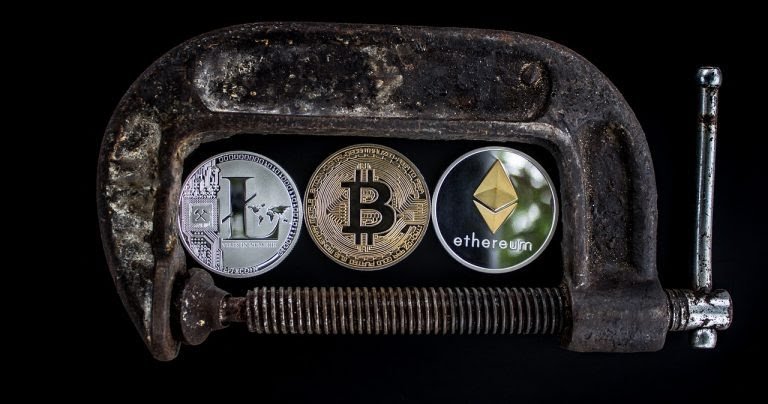
The highest court in India this week upheld the reserve bank's decree prohibiting the country's banks and other regulated lenders from dealing with or supporting any cryptocurrency-related services, including allowing customers to buy crypto with credit cards.
In April, the Reserve Bank of India gave banks three months to cease any activity with cryptocurrencies. The Supreme Court stood by the RBI’s blanket ban on crypto transactions despite the central bankers admitting that they had no guidance and did no research on blockchain or cryptocurrencies when deciding their new policy.
However, it should be of no surprise that crypto has been dismissed out of hand by Indian authorities as they are in the process of the world’s largest IT project - phasing cash out of its economy and digitizing its currency.
Meanwhile, the Indian rupee (INR) has been one of the worst performing emerging market currencies against the USD this year.
inrusd
How India is following China in economic surveillance
The two most promising markets for any industry or product, including blockchain, are India and China - with a combined population over a quarter of the world’s total and close to a billion people between the ages of 15 and 35.
We tend to think of China as the big brother state which has - all but for mining - outlawed cryptocurrencies entirely in the country. Considering the government has imposed capital controls on citizens taking money out of the country and intervenes directly with stock exchanges to control buying and selling, crypto presented a way for citizens to circumvent the Communist Party’s orders.
That door is now closed. Democratic India traditionally hasn't been viewed in the same light. India will soon surpass China in this style of heavy-handed economic oversight, however.
The US dollars’ status as the world's reserve currency is within the crosshairs of a resurgent Russia, and rising superpowers China and India who want to put an end to the US government’s debt jubilee (the world’s biggest debtor that prints money to repay debt denominated in its own currency) that has enabled it to run record-size deficits while hobbling the growth of other currencies.
usdcny
The USD versus the Chinese Yuan (CNY) since 1982.
usdinr
The USD versus Indian Rupee (INR) over the past 10 years.
It is no coincidence that China has become the world's biggest miner of cryptocurrencies while banning their use in the country. The Chinese government has benefited from the intellectual property of the mining companies in exchange for their special exemption, while at the same time working towards a digital Renminbi (RMB) to strengthen the currency and country overall, the state-owned Shanghai Daily reporting:
"The People’s Bank of China’s Institute of printing science is offering six positions for the design and development of digital currency-related software and hardware framework, a recruitment notice said, adding that candidates with experience in blockchain and Big Data technologies will be preferred... The candidates must hold master’s or doctoral degree in computer science, information security and cryptography, according to the notice.” - People's Bank of China
India moves to its own digital currency
Absent its recent growth spurt, the Indian economy has been a shambles for the past century hindered by bureaucracy and corruption.
To deal with the estimated 250 million people still unbanked in India and to crack down on the country’s notorious black market the government has made a world-first move to digitize its economy and eventually remove cash from the system altogether.
The hugely ambitious project plans to move the entire population to a biometric tracking system called Aadhaar that digitizes citizens’ money, identity and social insurance on to a card with their retina and fingerprint details.
The government links the Aadhaar card to a person’s everyday movements as a way to verify and trace transactions - from flight and train tickets, mobile phone numbers, to mutual funds and life insurance policies. From August, the government tax department will even start tracking social media profiles, gleaning photos and information from Facebook and Instagram etc to compare citizens’ lifestyle to their tax returns to prevent “tax evasion”.
China is already practically operating in a cashless economy as mobile payment apps like WeChatpay and Alipay are the main ways of transacting.
China is one of the world’s leading players in mobile or e-payment, which has made it possible for Chinese to buy a pancake at roadside breakfast stalls, order food online, pay credit card bills, and manage stock accounts with just a smartphone. Mobile payments in 2016 alone amounted to $5tr - double what they were as recently as 2015.
Conclusion
India's Aadhaar card is the Orwellian counterpart to cryptocurrencies and it is inevitable the government would remove any threat to this ambitious project. Despite the country being one of the fastest growing in the world for the past decade, with the best demographics and youngest population India is still rife with poverty, inefficiencies and suffering from a constant brain drain of talent.
As India tries to lift its economy out of the developing world and into the new it will need to repatriate the millions of highly-skilled engineering and IT graduates that have emigrated over the years and entice them back with a healthy economy free of corruption and a stable currency.
Source
Plagiarism is the copying & pasting of others work without giving credit to the original author or artist. Plagiarized posts are considered spam.
Spam is discouraged by the community, and may result in action from the cheetah bot.
More information and tips on sharing content.
If you believe this comment is in error, please contact us in #disputes on Discord